Alleviation: An International Journal of Nutrition, Gender & Social Development, ISSN 2348-9340
Volume 7, Number 7 (2020): 1-11
© Arya PG College (College with Potential for Excellence Status by UGC) & Business Press India Publication, Delhi
http://apcjournals.com, www.aryapgcollege.com
Reuse of Boutique Waste in Making One Piece Dresses
Nidhi Vats1 * and Aarti Chawla2
1Assistant Professor, CIS Kanya MahaVidyalaya, Pundri
(Haryana), India
2Assistant Professor, Kanya Maha Vidyalaya, Jalandhar
(Punjab), India
*Email: nidhi.vats32@yahoo.com
Abstract
The study entitled Reuse of Boutique Waste in Making One Piece Dresses was carried out in Ambala and Ludhiana city. An interview schedule was prepared for the purpose of collection of data related to the utilization of boutique waste from hundred respondents through purposive random sampling technique. The study focused on how left over fabric from boutiques considered as waste can be best managed to prevent the problems that waste causes to the environment and heath related issues. The study introduces the outcome of the utilization of the fabric from boutique in such a way so that it will reuse the waste fabric. Moreover, the study focused mainly on identifying waste fabrics that could produce apparel and utility items. In this context, waste fabrics included pieces of cotton, silk, blends of cotton fabrics from the boutiques and old clothes that are no more of use to their owners. The waste fabrics were used for making one piece dresses. In addition to it, the process related to the manufacturing of fashion products from waste also took place. The development of designs was done. After that, the selection of the most preferred designs and least preferred designs was done. On the basis of the preferences of respondents, the sourcing was done to collect the fabric waste for further construction of one piece dresses. Thus, the products created from the waste were liked by most of the respondents. The designed items fulfilled the fashion and variety needs of consumers
Keywords: One Piece Dress, Reuse, Textile Waste.
Introduction
Textiles have a long, distinguished history in the world and have an assortment of uses. The most common of which is for clothing. Textiles are made from many materials, with two main sources: natural and synthetic. The textile industries are one of the world’s largest industries. The production of textiles over the years has contributed to significant textile waste.
Textile waste is a material that is deemed unusable for its original purpose by the owner. Waste includes fashion and textile industry waste, created during the production of clothes. Textile or apparel waste is generally categorized as pre-consumer or post-consumer waste.
Apart from this, huge amount of the textile waste is also generated from the boutiques and fashion houses. Reusing of textile waste diverts textile waste away from landfill and prolongs the lifecycle of the textile material. Sourcing textile waste can seem challenging when compared to picking up a new fabric from a supplier, a trade fair or a store. However, sourcing textile waste is a fun and inspiring process that will shape the final design and stretch creativity skill (Wang 2006).
Fashion and clothing play an important role in our human society. For making it more interesting, there is a need to be well designed but if it is safe for environment, it would have dual advantage. Eco-fashion is not just good but an extraordinary idea in this world full of waste textiles.
The spurring up of utilization of resources in the modernized world has led to an increase in clothing and textiles dispose in the garbage rather than being reused. Thus, the aim of the study is to increase understanding regarding clothing and textile consumption that can become more sustainable by reusing the textile waste that is left in the boutiques.
Reusing of boutique waste in making one piece dresses is the call for the study. The need of the study is two- fold. The first need is the waste generated in terms of fabrics is very exclusive and needs to be utilized in some way so that it can benefit the organization itself by some long term solution by reusing that can always be applied to the waste generated. The second need is that reusing is a rarely used concept by Indian designers as compared to international designers and brands, as reusing is not easy to apply because the choice of material and method is not motivated primarily by beneficial opportunity or current trends but from concern for sustainability (Modi 2013).
Fashion products are those for which demand changes frequently because of change in consumer tastes or product attributes that include apparel items (Spacey 2017). Products were manufactured by reusing of textile waste from boutique. Apparel items such as one piece dresses are the most trending fashion garments which were generated from the textile waste from boutique. The good fabric pieces can be used for making new clothes.
The hand-made designs were created for the designing of apparel items. Thus, the illustrations of one piece dresses were created. With the help of illustrations, the developed designs of apparel items were shown to boutique holders. On the basis of the boutique owner’s preferences, the most preferred designs and least preferred designs were selected and after the selection of designs, fashion products are constructed.
The current trends of reusing and refashioning of textiles with boutique waste is considered to be the adaptable textile, the present study has been planned with the following objectives:
• To assess the amount of fabric waste generated in the boutique.
• To re-design the waste fabrics.
• To bring fabric waste back into production.
The present study has following limitations:
• The study was limited to only two cities i.e. Ambala and Ludhiana.
• The study was limited with only boutique waste fabrics by reusing them because of their availability in making apparel items.
• Waste fabrics that were accessible include natural as well as man-made fibers.
Methodology
An experimental method was used and questionnaire was there to obtain information regarding the most preferred style of one piece dresses from the textile waste left in the boutiques. The study was conducted to the selected participants that are boutique holders of two cities namely Ambala and Ludhiana. The sample size of study was 100 and the respondents who were selected randomly from two cities were asked to fill the questionnaire for data collection. The questionnaire contained questions regarding the background of the respondents, their customer handling and the waste utilization.
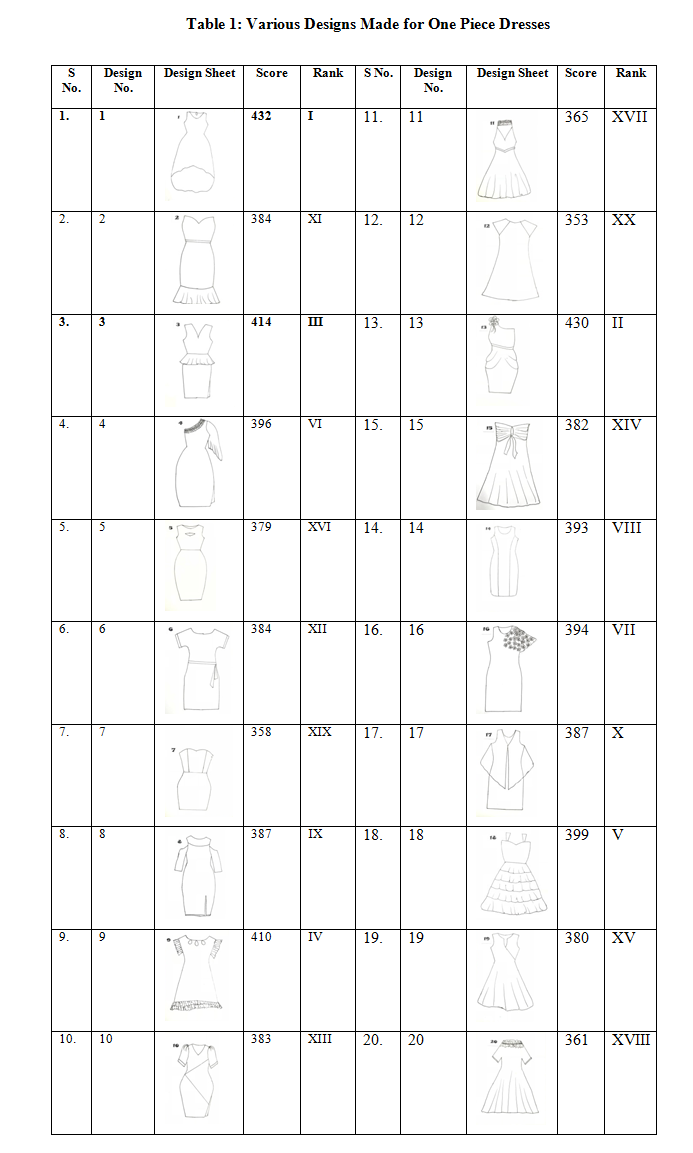
Results and Discussion
The data collected through questionnaire and observations were analyzed and it was examined that 86.4 per cent of the respondents gave the highest scores and rank to design number 1 that can be prepared from waste fabrics (Table 1). Moreover, 86 per cent of respondents gave the second highest scores to the design number 13
that can be prepared from waste fabrics and 82.8 per cent of respondents gave
the third highest scores to design number 3 that can be prepared from waste fabrics.
It is noticed from Figure 1 that with regards to utility as a parameter,
maximum number of respondents (46%) graded excellent and 25 per cent of respondents graded very good to design-III. Apart from this, the maximum number of respondents (45%) graded excellent and 18 per cent of respondents (18%) graded good to design-II. The maximum number of respondents (41%) graded very good and 22 per cent of respondents graded good to one piece dress design-I.
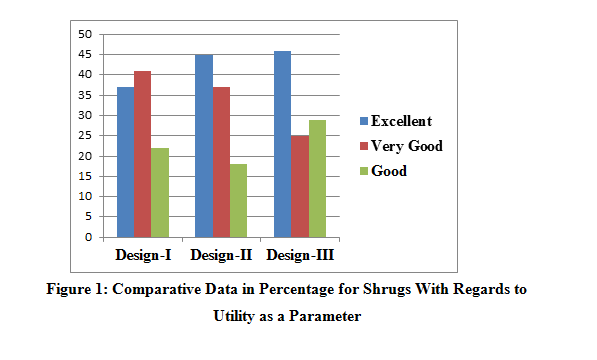 It can be seen from data depicted in Figure 2 that with regards to functionality as a parameter, maximum number of respondents graded very good (52%) and 8 per cent of respondents graded good to design-II. The maximum number of respondents (45%) graded very good and 17 per cent of respondents graded good to design-III. The 39 per cent of respondents graded very good and 25 per cent of respondents graded good to one piece dress design-I.
It can be seen from data depicted in Figure 2 that with regards to functionality as a parameter, maximum number of respondents graded very good (52%) and 8 per cent of respondents graded good to design-II. The maximum number of respondents (45%) graded very good and 17 per cent of respondents graded good to design-III. The 39 per cent of respondents graded very good and 25 per cent of respondents graded good to one piece dress design-I.
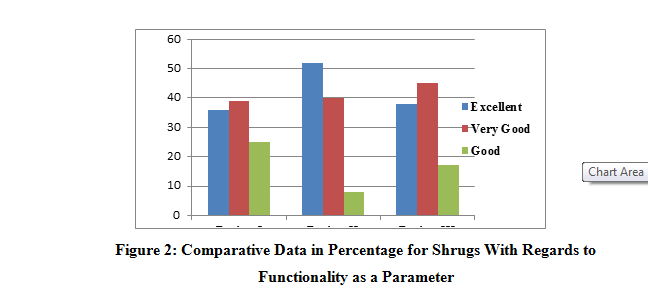 It can be noticed from Figure 3 that with regards to serviceability as a parameter that 61 per cent of respondents graded excellent and 3 per cent of respondents graded good to design-III, whereas 55 per cent of respondents graded excellent and 10 per cent of respondents graded good to one piece dress design-I. Forty one per cent of respondents graded excellent and 26 per cent of respondents graded very good to design-II.
It can be noticed from Figure 3 that with regards to serviceability as a parameter that 61 per cent of respondents graded excellent and 3 per cent of respondents graded good to design-III, whereas 55 per cent of respondents graded excellent and 10 per cent of respondents graded good to one piece dress design-I. Forty one per cent of respondents graded excellent and 26 per cent of respondents graded very good to design-II.
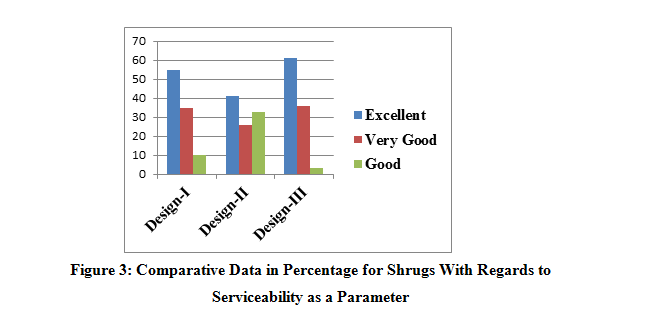 It can be seen from data depicted in Figure 4 that with regards to trimmings as a parameter, 58 per cent gave excellent to very good (19%) to design-III, whereas 40 per cent of respondents gave very good to excellent (22%) for design-II and 38 per cent of respondents gave very good to good (30%) response to design-I.
It can be seen from data depicted in Figure 4 that with regards to trimmings as a parameter, 58 per cent gave excellent to very good (19%) to design-III, whereas 40 per cent of respondents gave very good to excellent (22%) for design-II and 38 per cent of respondents gave very good to good (30%) response to design-I.
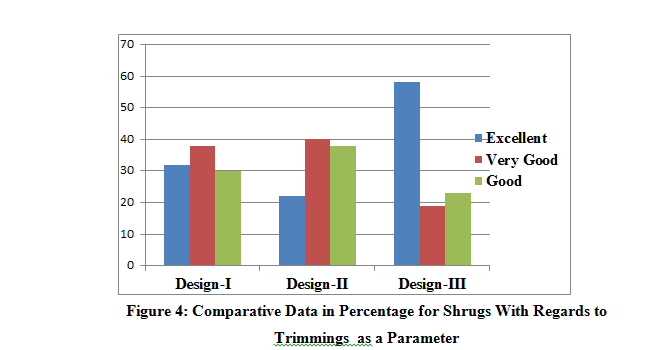 • With regards to overall aesthetic appeal as a parameter, it can be seen from Figure 5 that 65 per cent of respondents gave excellent response and 12 per cent of respondents graded good to design-I, whereas 63 per cent of the respondents gave excellent to good (8%) to design-II, 39 per cent gave excellent to good (30%) response to design-III.
• With regards to overall aesthetic appeal as a parameter, it can be seen from Figure 5 that 65 per cent of respondents gave excellent response and 12 per cent of respondents graded good to design-I, whereas 63 per cent of the respondents gave excellent to good (8%) to design-II, 39 per cent gave excellent to good (30%) response to design-III.
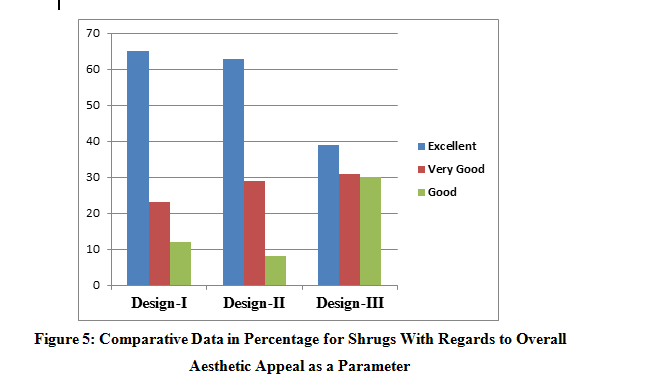 It was found that respondents gave the highest scores and rank to design number 1, second highest score to the design number 13 and third highest score to design number 3 that can be prepared from waste fabrics.
It was found that respondents gave the highest scores and rank to design number 1, second highest score to the design number 13 and third highest score to design number 3 that can be prepared from waste fabrics.
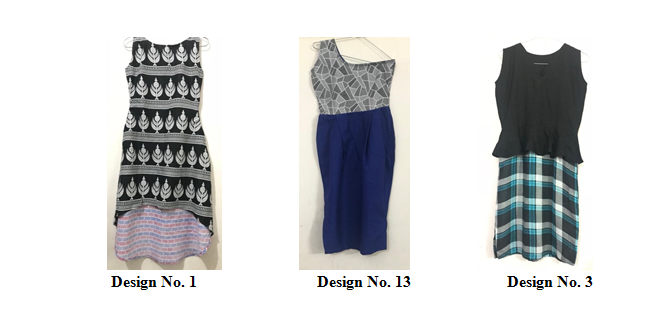
Conclusion
It was found that innovative items created by using boutique waste are liked by everyone. Apart from it, this will help to minimize some of the textile waste produced by boutique holders who are contributing socially towards environment protection. Thus, it will help in sustainable development and stops land fillings.
It can be concluded from the study that most of the respondents were highly inclined towards the items made from boutique waste fabrics. Moreover, the respondents were also ready to buy the apparel items. The designed items fulfilled the fashion and variety needs of consumers. Thus, it can be said that designing techniques used in this study helped in improving the aesthetic appeal of the products.
Suggestions
On the basis of the findings of the study, it is suggested that:
• Study on the construction of handicraft items can be conducted with fabric waste.
• A similar study can be conducted on the manufacturing of household articles from wastes fabrics.
• This study can help the entrepreneurs to start a new business of making items from waste.
References
Bairagi N (2014) Recycling of Textiles in India, J Textile Sci Eng S, 2: 03.
Chan TS (1996) Recycling in Textile and Clothing Sector, J Int Cons Mktg, 9 (1): 10-15.
Gulati (1979) A Renovation of Discarded Garments and Preferences of Low Middle Class Women on the Renovated Garments, MSc Thesis, MS University, Baroda, India. In Wadhawan P (2003) MSc Thesis, Punjab Agricultural University, Ludhiana
Hawley JM (2006) Textile Recycling: A System Perspective. In Wang Y (Ed.) Recycling in Textiles. Cambridge: Woodhead Publishing Limited.
Katkar PM & Bairgadar SM (2010) Textile Waste Recycling. Available at www.fibre2fashion.com › Knowledge › Article › Textile
Modi D (2013) Upcycling of Fabric Waste in Design Studio. Master in Design of the National Institute of Fashion Technology at Mumbai, Mumbai.
Spacey J (2017) 12 Types of Fashion Product. Available at simplicable.com › new › fashion-products.
Wang Y (2006) Recycling in Textiles. Cambridge: Woodhead Publishing.

